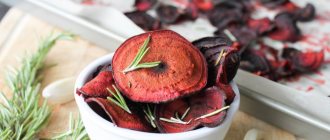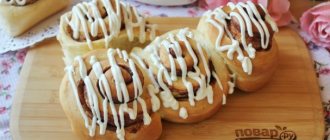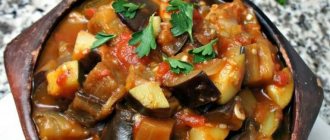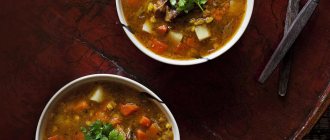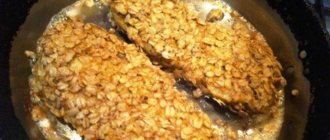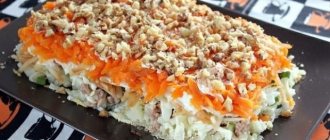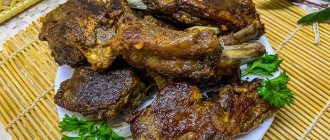Reviews (3)
7
Prepared by: Evdokia Antonova
06/25/2017 Cooking time: 20 min
| Save | I cooked) | Estimate |
Yakisoba is a Japanese dish that involves cooked quick noodles with chicken or pork. Less commonly, yakisoba is prepared with seafood. Most often the dish is prepared in a wok, but you can also do it without it.
What kind of dish is this?
The yakisoba recipe is widely known throughout Japan and far beyond its borders: these are instant noodles generously flavored with fried meat fillet and thinly sliced vegetables. Sometimes they add mushrooms, various greens, cabbage, nori and, of course, yakisoba sauce, which is sold in abundance in Asian countries.
Each prefecture in Japan has its own unique recipe, because preparing yakisoba is always a special art of a cook who knows how to combine a variety of flavors.
Nutritional and energy value:
| Ready meals | |||
| kcal 1254.2 kcal | proteins 85.9 g | fat 54.8 g | carbohydrates 99.3 g |
| Portions | |||
| kcal 418.1 kcal | proteins 28.6 g | fat 18.3 g | carbohydrates 33.1 g |
| 100 g dish | |||
| kcal 117.2 kcal | proteins 8 g | fat 5.1 g | carbohydrates 9.3 g |
Features of product selection
The yakisoba recipe used in Japan differs somewhat from that usual in the post-Soviet space precisely in the main ingredient - noodles. In our country they use noodles made from buckwheat flour, and in Asia they use egg noodles for ramen (instant noodles) or regular thin spaghetti made from durum wheat. Why this discrepancy?
The confusion arose from the name: soba is really noodles made from buckwheat flour, “yakisoba” means “fried noodles in sauce”, but all Asian cooks know that the flour product made from buckwheat flour is quite capricious and requires proper preparation in the shortest possible time, which Not everyone succeeds. Therefore, they began to use noodles for this dish made from wheat, but quickly prepared, because, in fact, the name accurately conveys the essence of the dish.
Benefits of buckwheat noodles
The dish can be prepared from egg or wheat noodles, but buckwheat is the most healthy. It helps regulate blood sugar levels, promotes weight loss, improves the digestive process and relieves heartburn attacks.
Benefit! Soba is rich in magnesium, potassium, zinc, calcium, sodium, copper and manganese. As well as fiber, iron, phosphorus, selenium, B vitamins and amino acids.
The listed microelements have a beneficial effect on the condition of hair, nails, teeth, skin and the entire human body as a whole.
List of required ingredients
It is most often prepared according to the yakisoba recipe with pork, although, by and large, the meat does not play a special role. The main thing is that there is enough of it, and pork, chicken or veal is a matter of taste and preference of the cook. So, what is needed to prepare a portion for two people:
- 500 grams of pork fillet, cut into thin strips at least three centimeters long.
- Three hundred grams of soba noodles made from durum wheat.
- Onion, carrot and bell pepper - one each.
- Three hundred grams of white cabbage or Chinese cabbage (your choice).
- One hundred grams of soybean sprouts (optional, but this is a traditional ingredient for Japan).
- A few tablespoons of vegetable oil.
- Yakisoba sauce - 70 grams, can be replaced with teriyaki sauce.
Also when serving, light sesame seeds, chopped green onions, cilantro, and pickled pink ginger are often used. These are not required components of the yakisoba noodles recipe, but they add a unique Asian flavor to the dish and a specific taste.
Calorie content of foods possible in the dish
- Boar ham – 113 kcal/100g
- Pork – 259 kcal/100g
- Pork – lean roast – 184 kcal/100g
- Pork – chop on the bone – 537 kcal/100g
- Pork – shoulder – 593 kcal/100g
- Pork – schnitzel – 352 kcal/100g
- Fatty pork – 333 kcal/100g
- Pork meat – 357 kcal/100g
- Sweet pepper – 27 kcal/100g
- Carrots – 33 kcal/100g
- Boiled carrots – 25 kcal/100g
- Dried carrots – 275 kcal/100g
- Garlic – 143 kcal/100g
- Soy sauce – 51 kcal/100g
- Sugar – 398 kcal/100g
- Granulated sugar – 398 kcal/100g
- Buckwheat noodles – 348 kcal/100g
Calorie content of foods: Buckwheat noodles, Pork, Bell pepper, Carrots, Soy sauce, Garlic, Sugar
Step-by-step preparation
The process of preparing this dish begins with preparing the vegetables: peel the onion and chop into thin half rings, remove the seeds from the sweet pepper and cut into long strips no more than 0.5 cm thick. Wash the carrots thoroughly, remove the outer skin if necessary, then cut into slices using a vegetable peeler. . If you don’t have it, you can grate the vegetable using a Korean carrot grater. Cabbage is usually cut into squares up to three cm wide, but if this shape seems unusual, then you can use a more classic version - into strips.
Heat the oil in a saucepan, place pieces of pork in it and fry over high heat until the color of the meat changes. Then add the onions, peppers and carrots, stir and fry for another three minutes, stirring occasionally. It is important not to simmer the vegetables - everything cooks quite quickly so that they retain a slight crunch.
Then pour in the sauce, mix thoroughly and simmer for a few more minutes (no more than five). While cooking the vegetables, boil the noodles in plenty of water for as long as indicated on the label—usually no more than five minutes. Place the finished noodles in a colander, drain and pour over one spoon of any vegetable oil, mix and add to the vegetables in the frying pan. Add soy sprouts. Using two spoons or a wide wooden spatula, stir the contents of the pan and simmer over low heat for two minutes, then serve.
Recipe: Beef Yakisoba Sauce
Let's look at everything we need. After a long search, I found this sauce recipe: Soy sauce 100 ml Mirin 30 ml Ketchup 20 ml Sugar 30 g Oyster sauce 150 ml Ajinomoto (monosodium glutamate) 1 g Here, only mirin is unclear. This is something like a tincture of rice and rice buds in vodka. in short, there’s not much of it there; you can splash in some chef’s wine or port. Yes - and we don’t need that much sauce - we have fried noodles (YAKI soba)
Once again - more closely. Cut the beef into pieces (petals) approximately the thickness of thin cardboard. I don’t know how to achieve this. This is the most common form of meat sales here.
Cabbage (cut as desired - not very finely and fry in vegetable oil. Sometimes other vegetables are added - onions, carrots, peppers. Pampering, in my opinion.
We don’t worry, but rejoice if it is well fried somewhere and acquires the “color of a fox”
When the cabbage has reduced in volume by three times, add the meat and continue to fry, stirring, for another three minutes.
Add noodles and fry for 5 minutes, stirring
Add sauce and fry until done. It should not be too wet, but not too dry either.
We wash it down with dry red wine, regretting that there is no additive. We wonder where the whole head of cabbage went.
There are three difficulties.
1. “Yakisoba” (fried noodles) refers to several quite different dishes. That's why today we have SOUSU-YAKISOBA - a Japanese folk dish.
2. Due to its distinct nationality, you are unlikely to find this dish on the menu of cool restaurants. But you will definitely find it among the everyday dishes of the Japanese family, as well as “at the exit” - in unpretentious eateries of all sorts of zoos, just parks, folk festivals, etc. What they sell you there for 400 yen will be quite different from what you buy there. what we will try to prepare today, but nevertheless will be able to constitute a healthy alternative to the other tempting offers. The folk trail near the yakisoba tent (you don’t need to specify there - there are no others in those parts) never becomes overgrown.
3. The most important component of yakisoba sauce is the sauce (sorry for the tautology). In the store, the required amount of powdered sauce is sold along with a portion of noodles. No one (except me and other idiots) is interested in what this sauce consists of. We will still try to figure out what it is, so that you can prepare yakisoba before the corresponding semi-finished products are delivered.
Soba with chicken and egg
Those who don't really like pork can prepare chicken yakisoba using the recipe below:
- Cut 350 grams of chicken fillet into small pieces, fry over high heat in two tablespoons of vegetable oil until the color changes, under no circumstances fry until brown.
- Chop one red onion into half rings and add to the meat, add one bell pepper, cut into thin long strips. Continue the cooking process for another two to three minutes, then add 100 grams of soybean sprouts, if available. If not, you can do without them. The yakisoba noodles recipe suggests not always using them.
- Mix 100 grams of water with 50 grams of teriyaki sauce; if you have the original yakisoba sauce, then, of course, it is better to use it. Pour the resulting mixture into the meat and vegetables and simmer for five minutes.
- Meanwhile, in a separate bowl, boil 180 grams of soba noodles, making sure that they do not overcook: yakisoba softened and falling apart is a sad sight. Drain in a colander, allow excess liquid to drain and add to vegetables.
Simmer the contents of the pan over low heat for a few more minutes. Separately, fry the egg so that the yolk remains liquid and the white remains firm. When serving, place the prepared noodles with vegetables and meat in a portioned plate, and carefully place the egg on top, making sure that the yolk does not spread. You can sprinkle a small amount of mashed nori leaves (dried) or chopped green onions on top.
Fried Yakisoba Noodles
Fried Yakisoba Noodles
Fried Yakisoba Noodles
(Japanese: 焼きそば, rH. Yakisoba) is a traditional dish of national Japanese cuisine. Although it is Japanese, its roots come from China - it is believed that the Japanese adopted it from the Chinese at the beginning of the 20th century. Yakisoba noodles are a variation of the mega-popular and famous dish far beyond the borders of China, “Chow Mein Noodles” (Chinese: 炒面, pinyin Caomian). For example, in the United States, Chow Mein noodles are one of the most famous and popular dishes in American Chinese restaurants.
Yakisoba literally means “fried noodles in sauce.” By the way, although the word “yakisoba” contains the name Soba noodles made from buckwheat flour, buckwheat noodles have nothing to do with this dish. It is made from another noodle - wheat Ramen. For this dish, the noodles are steamed (or simply in water). In Russia, similar dishes (made from noodles) are called “wok”. Actually, the slogan “collect your own box of noodles” is just about Chow Mein and Yakisoba. Yakisoba has two main ingredients - noodles and sauce. The sauce consists of five ingredients (Worcestershire sauce, oyster sauce, ketchup, light soy sauce and sugar). It is dark in color, thick, has a salty-sweet taste with a slight hint of sourness; it is the sauce that sets the main taste of the dish, and the toppings only complement the overall taste perception.
Toppings (additional additives to the noodles) are added as desired. The most popular are: meat (most often pork) or seafood (squid, shrimp, etc.), vegetables (carrots, white cabbage, Chinese cabbage, Chinese cabbage pak choi), soybean or mung bean sprouts, onions and green onions, shiitake mushrooms, tofu, tenkasu (blobs of tempura batter dropped into hot oil), fried egg, fried egg strips, canned bamboo shoots, nori, red pickled ginger, bonito tuna flakes. It is possible to add soy mayonnaise and Shichimi Togarashi hot seasoning. In general, the dish is tasty, filling and aromatic. Prepares quickly.
In Japan, there are many regional variations of Yakisoba - more than 50. Almost every locality has its own version of preparing the dish. Yakisoba noodles are produced in the form of freeze-dried instant noodles.
Some variations of this dish are interesting. For example, in Japan there is a hot dog Yakisoba pan (Japanese: 焼きそばパン, rH. Yakisoba pan), where instead of sausage there are Yakisoba noodles. Or noodles with rice, or even no noodles at all, just rice with Yakisoba sauce (Japanese: 焼きそばライス, rH. Yakisoba raisu). Or fried noodles with Italian spaghetti.
Making fried Yakisoba noodles at home is not difficult; you can easily buy the necessary ingredients. Worth a try. We'll tell you how to do this.
For 2 servings you will need:
- ramen noodles – 150 g,
- onion – 1 small head,
- carrots - half medium,
- dried shiitake mushrooms – 3-4 pcs.,
- green onion – 1 stalk,
- cabbage leaf - 1 small,
- pork (can be with fat, such as bacon) – 100 g,
- refined vegetable oil – 2 tbsp.,
- ground black pepper (preferably freshly ground) - to taste,
- Yakisoba sauce – 2-3 tbsp. (or to taste).
To serve the dish (optional):
- thinly sliced strips of dried nori seaweed,
- red pickled ginger (as for sushi).
This simple dish has two main ingredients - Ramen noodles and Yakisoba sauce. You can (if possible) buy the sauce ready-made. But if this is not possible, it doesn’t matter, it can be prepared at home. The main thing is that all the ingredients are available. If you're interested in Asian cuisine, chances are you've got it covered. We have already talked about how to make homemade Yakisoba sauce.
Now the noodles. For this dish it is steamed. In Japan, the noodles for this dish are sold ready-to-use - they are already boiled and treated with vegetable oil. The noodles are sold chilled. All the cook has to do is rinse it with hot water to remove the oil and cook it. But this is in Japan. In Russia, Asian noodles are sold dry. It needs to be boiled according to the instructions on the package - usually cook for 3-4 minutes in boiling water. And here there is one nuance. You can boil the noodles just before cooking, but if you’re not too lazy, you can do this in advance, say, in the evening, then put it on a sieve and sprinkle with vegetable oil. Stir gently until the vegetable oil coats the noodles. Allow the liquid (remaining water and oil) to drain – about 10 minutes or so. And then put the noodles in a bag and put them in the refrigerator. Overnight it will become elastic, will not stick together into a lump and will not tear when stirred during cooking. Before frying, you can rinse the noodles with hot water to remove the oil. You can also pre-fry it - then the noodles in the finished dish will not only be elastic, but also have a crunch. The main thing is not to overdo it, otherwise it will break.
So, there is sauce, and so are the noodles. Now let's start processing the toppings for the noodles. We will have pork, shiitake mushrooms (called xianggu in China), carrots, white cabbage, onions and green onions. So to speak, the basic set. You can use seafood instead of meat, such as squid and shrimp; vegetarians can replace meat with tofu. You don’t have to use shiitake at all – it’s not for everyone.
Soak dried shiitake mushrooms in warm water about 30 minutes in advance. Or defrost ice cream (there are some like that). Or it’s really good to take fresh shiitake mushrooms (they are also sold).
Rinse the green onions and cut them into 2-3 cm pieces (only the white part).
Peel and cut the onion into segments (similar to tangerine slices) and separate the segments into layers. Rinse the carrots and cabbage leaves, peel the carrots from the top layer (like potatoes) and cut into strips (or shred on a grater for Korean carrots), and tear the cabbage leaves into small pieces the size of a 2-ruble coin.
Prepare the noodles (boil or remove pre-cooked noodles from the refrigerator).
Remove the remaining stems from the shiitake mushrooms - they are tough and cannot be eaten, and cut the caps lengthwise into strips. Cut the meat into thin slices. This is best done from pre-frozen meat and with a sharp knife. Thin slices will be ready in a wok (or frying pan) in just a couple of minutes.
Heat vegetable oil in a wok (or frying pan) over medium heat and quickly fry the meat, stirring constantly, until white.
Add carrots and cabbage to the wok, stirring, cook meat and vegetables for another 1-2 minutes. The cabbage should be slightly limp.
Add the green onion pieces and shiitake mushrooms to the wok. Continue cooking, stirring, for another 1 minute. Pepper the contents of the wok and mix everything.
Add noodles to the wok and stir the contents of the wok again.
Add Yakisoba sauce to the wok and stir the contents of the wok again to coat the noodles and other ingredients with the sauce. If the specified amount of sauce is not enough, add more.
The dish is ready. Transfer to serving plates and serve hot. In a bowl, place nori strips and a handful of red pickled ginger on top of the mound of noodles. You can help yourself.
With buckwheat noodles: recipe with photo
Yakisoba with buckwheat noodles is also possible, but it is important not to overcook it, otherwise it will break into pieces, since it does not contain gluten to hold the noodle strands together into a strong structure. Therefore, you need to cook it for no more than eight minutes, or even a little less, because it will reach the desired condition during the process of frying with meat and vegetables.
The following proportions are used for preparation:
- 200 grams of noodles;
- 300 grams of meat fillet, cut into thin slices;
- 150 grams of cabbage, cut into small squares;
- one onion, thinly sliced, and carrots into strips;
- 5-7 tbsp. spoons of yakisoba sauce;
- several green onions;
- 1 tbsp. a spoonful of light sesame seeds;
- 1/2 small chili pepper.
How to cook soba at home
To save time, you can buy a ready-made semi-finished product in the store. But if you want to prepare an absolutely natural homemade product, then this is possible. The result will justify the effort and time spent.
To prepare soba at home you will need the following ingredients:
- 1 kilo of buckwheat flour;
- 450 gr. unbleached wheat flour;
- 2 glasses of water with a temperature of 70-75°C.
Instructions for creating a product:
- Sift both types of flour and mix in a bowl. Gradually add hot water and knead the dough until smooth.
- Next, knead the dough ball on the table until elastic and air bubbles are completely removed.
- Divide into several parts and roll each into a thin pancake, about 3 mm thick.
- Using a sharp knife, cut each pancake into thin strips.
The noodles are ready, you can cook them immediately or, divide them into portions, put them in the freezer for future use. The aroma of the product has a pronounced buckwheat bitterness, and the taste is richly nutty.
Preparation
The principle of preparing yakisoba with buckwheat noodles is the same as with wheat noodles: first the meat is fried, then onions are added to it, after a minute carrots and cabbage. The sauce is added, combined with finely chopped chili pepper, and the whole mass is simmered for several minutes.
The noodles are boiled separately and placed in a common pot. Next, simmer for another five minutes and serve immediately, sprinkled with onions and sesame seeds, lightly fried in a dry frying pan for flavor.
If desired, you can add a few pickled mushrooms, cut into pieces, or Brussels sprouts or cauliflower florets instead of cabbage leaves during the process.
The good thing about the recipe for this dish is that it can be modified based on the taste preferences of the cook, as well as the availability of products. Don't forget the most important ingredient that makes these noodles so exceptional - the sauce.
Video: Yakisoba with pork from the chef
We all love to eat. Anime characters also need meals. In works of Japanese animation, you can find both food products that are widespread in Japan and exquisite culinary masterpieces from the chef-fighter Soma. So let's take a closer look at them.
Onigiri
A common rice dish in Japan with or without various toppings. Often used by schoolchildren in bento. The only thing Taiga from Toradora can do.
Ramen
Many people associate ramen with Naruto. Quite justifiably, almost everyone looked at this yellow-haired prankster at least a little. But this dish is famous not only due to the spread of Naruto, this dish is in every eatery in Japan, light versions of ramen can be bought in the supermarket instead of doshik. Overall a good dish.
Sauce for the dish
If it is not possible to buy the original sauce, then you can prepare yakisoba sauce according to the recipe that we will share below. You will need the following products:
- Classic soy sauce without additives, fish or oyster sauce, Worcestershire sauce - two tablespoons each. spoons.
- Sesame oil – 1 tbsp. spoon and the same amount of sugar, which can be replaced with honey if desired.
Mix all ingredients in one bowl, season with ground black pepper if desired. There is no need to pre-boil or heat it; you can immediately add it to the vegetables in the frying pan.
Yakisoba bun
Another version of the dish, more convenient for a quick snack. To prepare, you need to buy hot dog buns and prepare Yakisoba in the way you like.
Next, cut the buns lengthwise, not all the way, and fill them with noodle filling. The food can be topped with ketchup, mayonnaise or any other seasoning.
It’s quick and easy to prepare, and if you add spices in moderation, it’s useful even for children. Fans of spicy food can diversify the recipe with chili paste, garlic, ginger root and other hot spices.
Yakisoba noodles are a godsend for lovers of culinary experiments. Adding different ingredients gives the dish a new taste each time.
